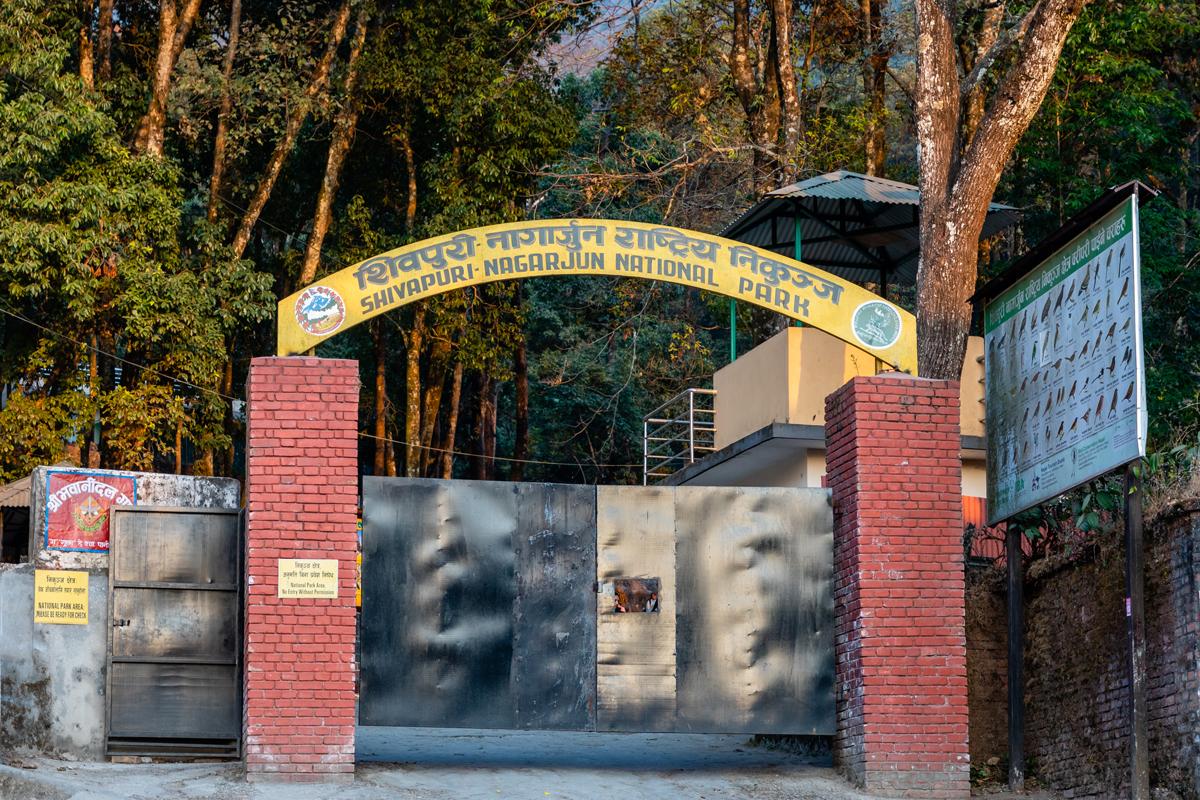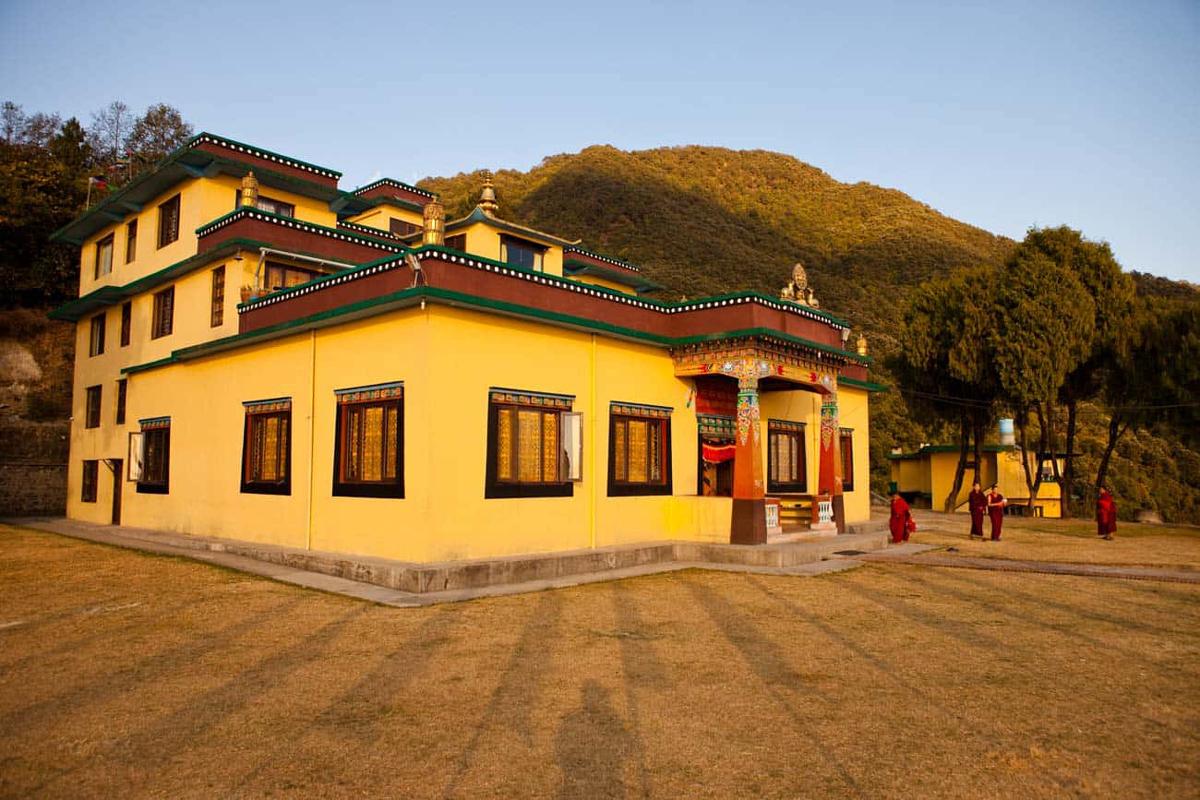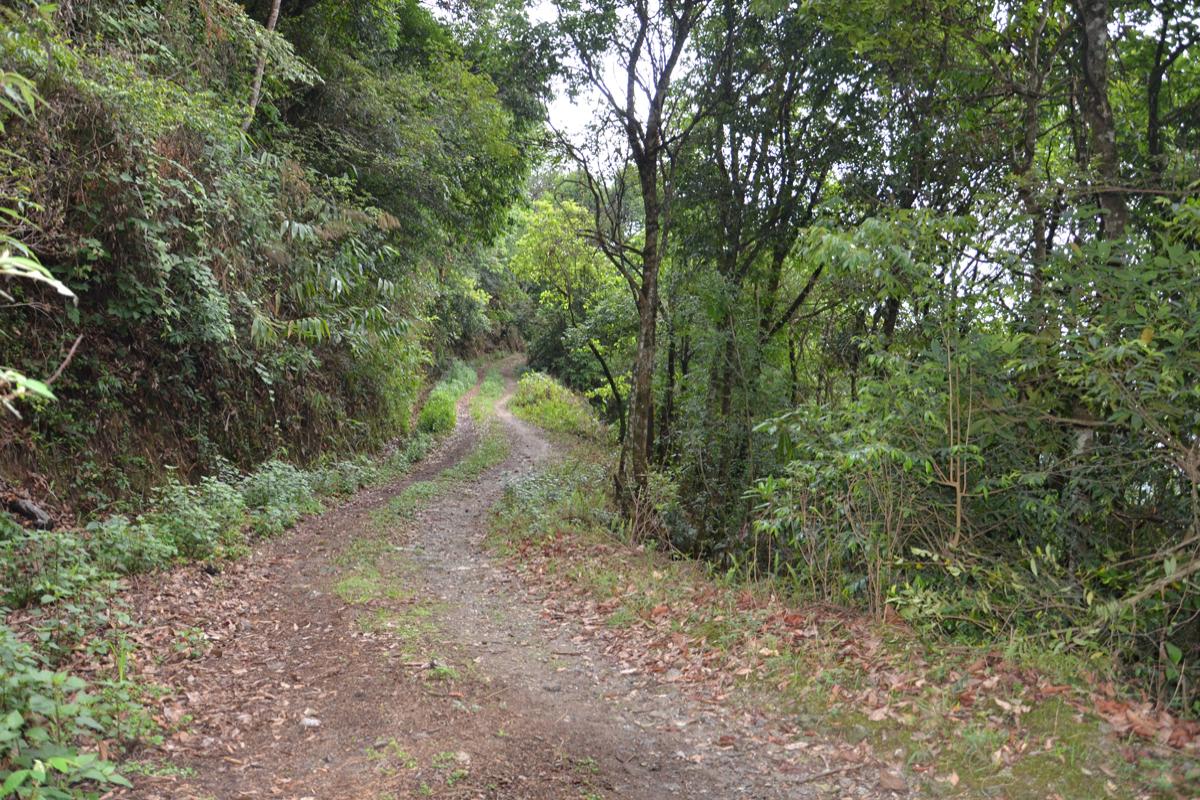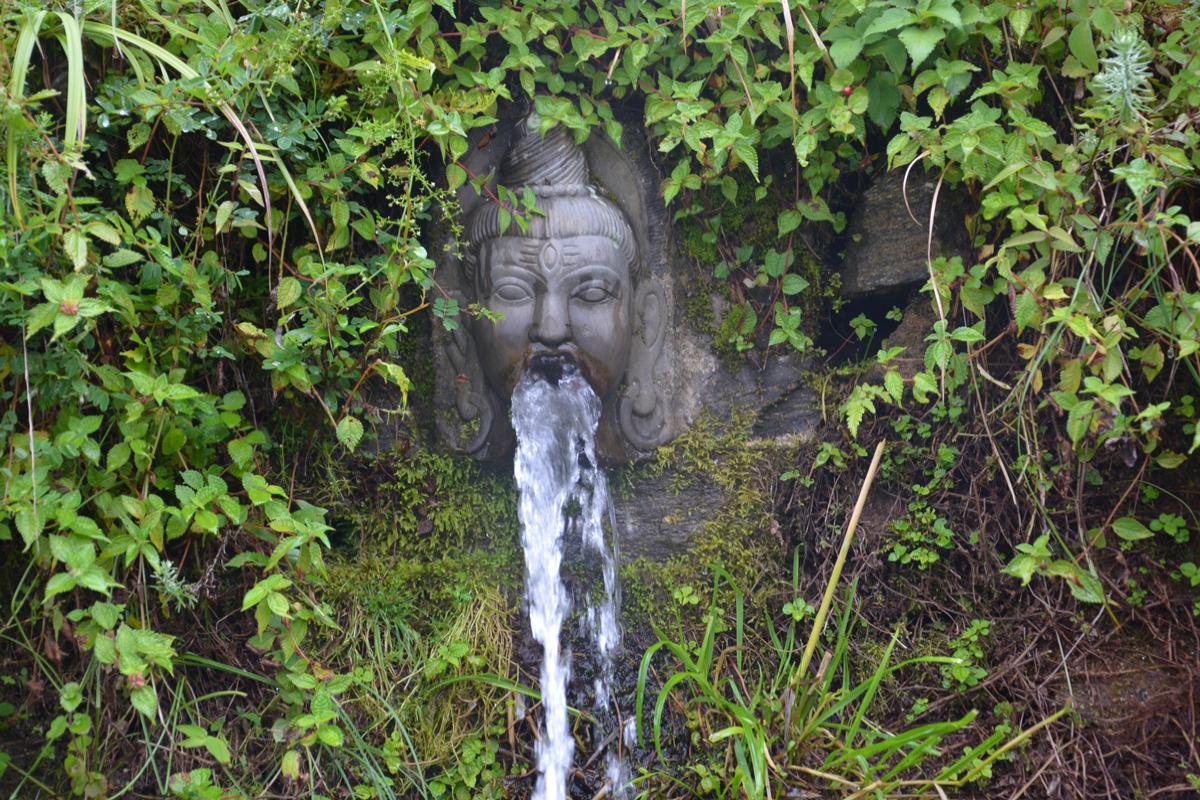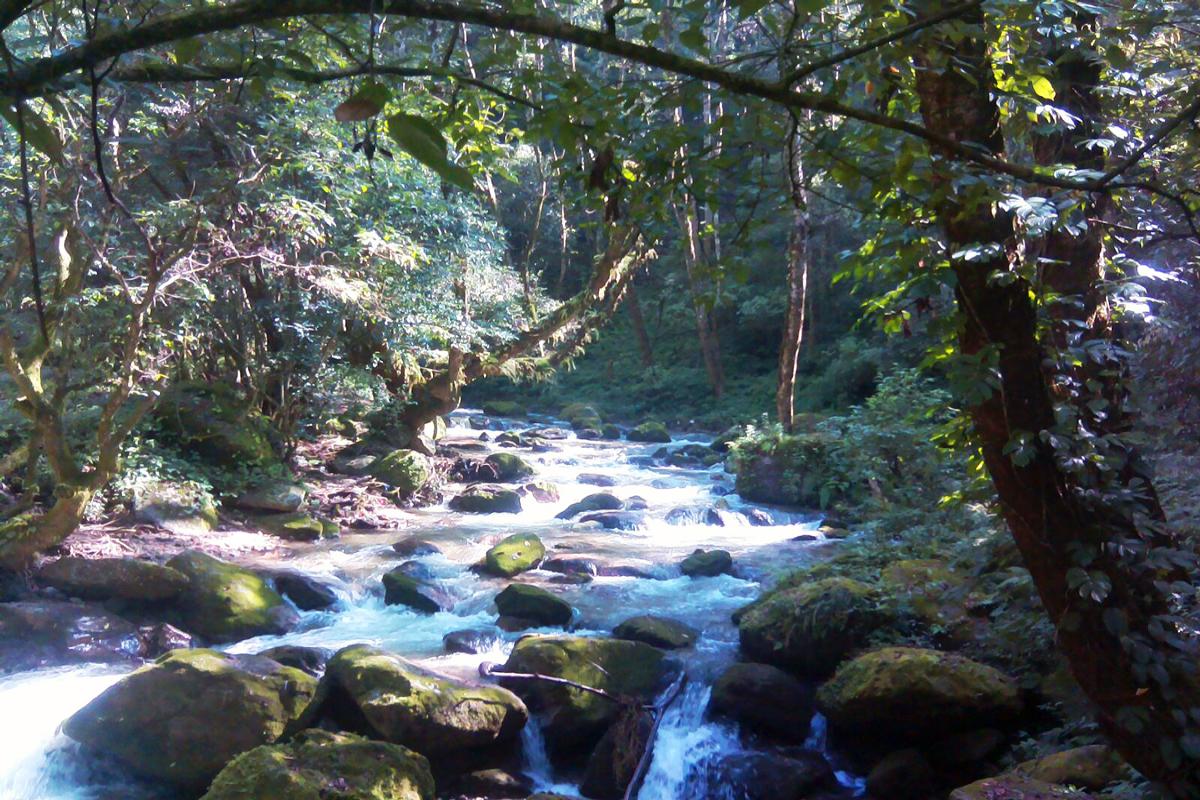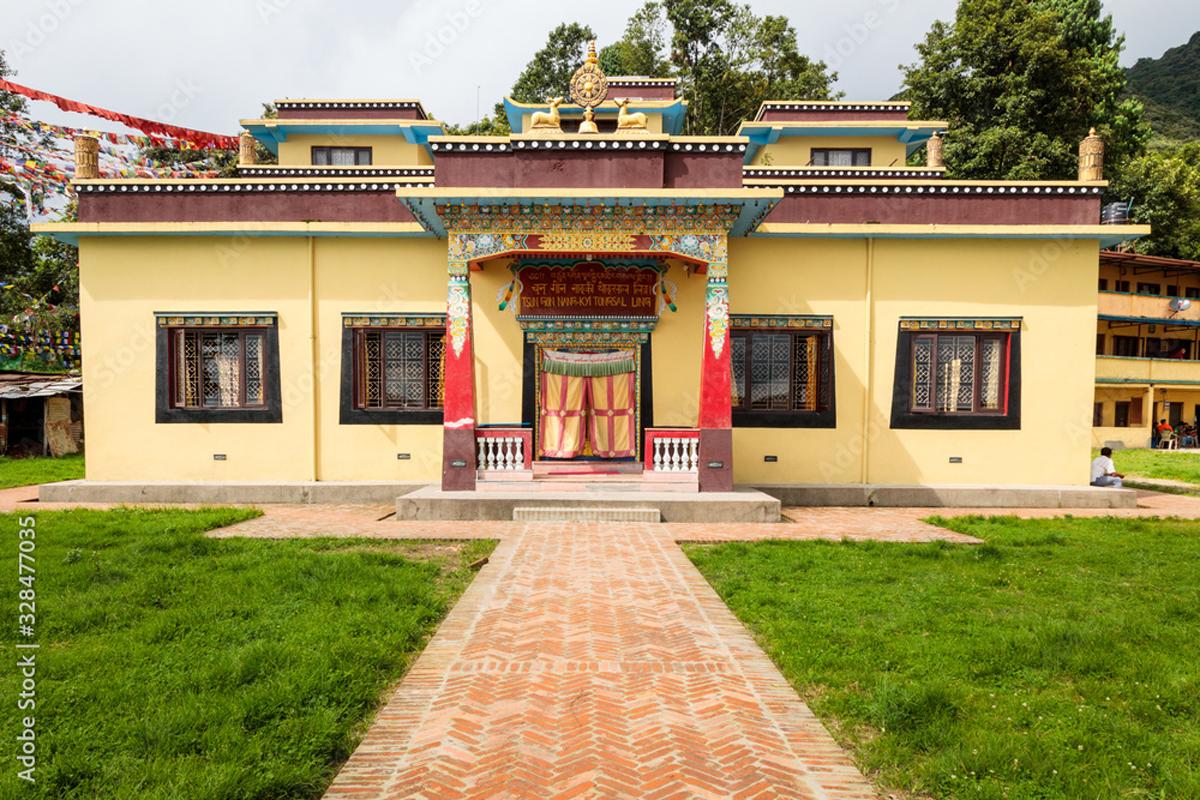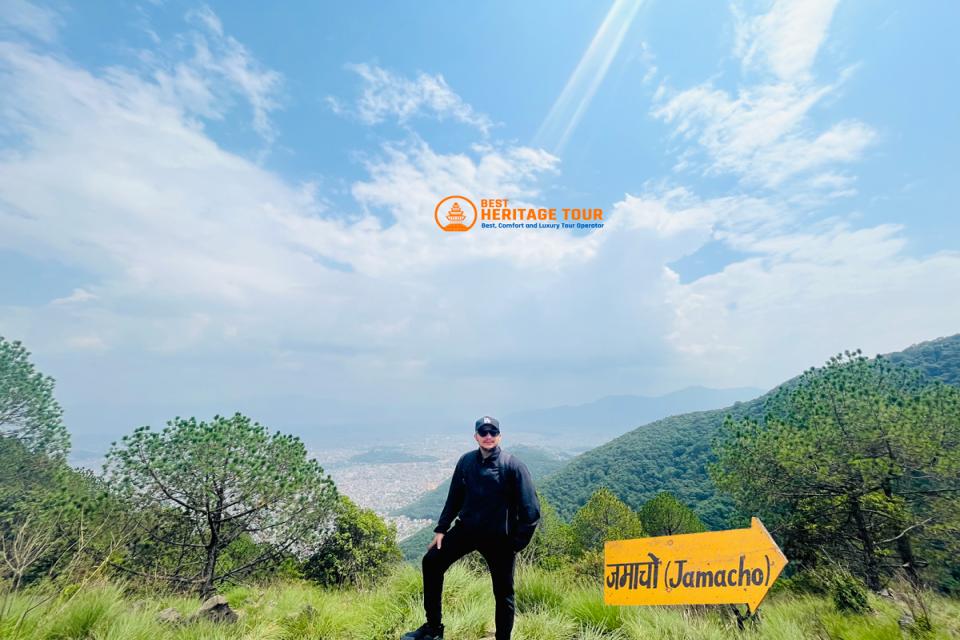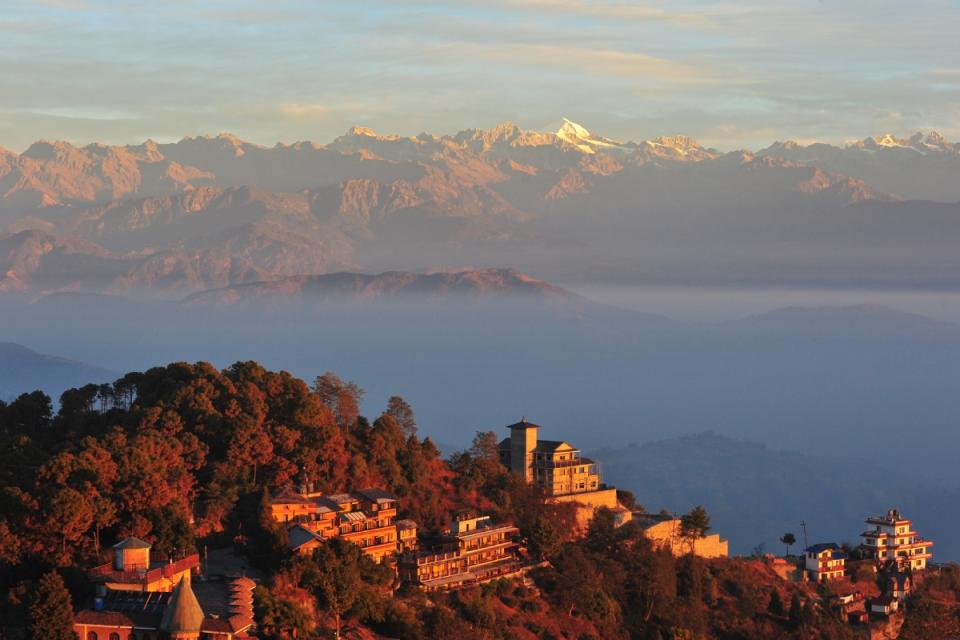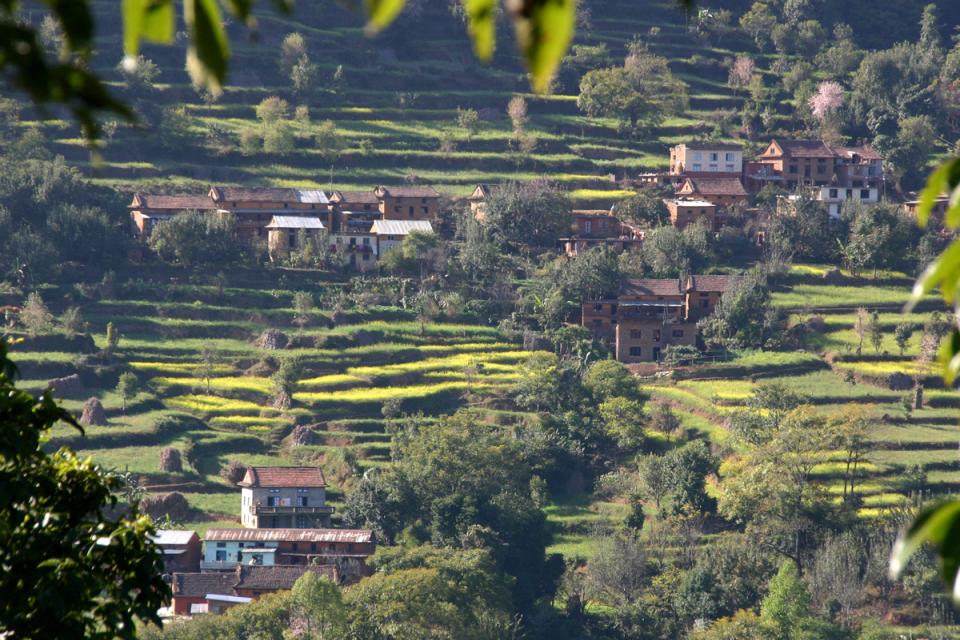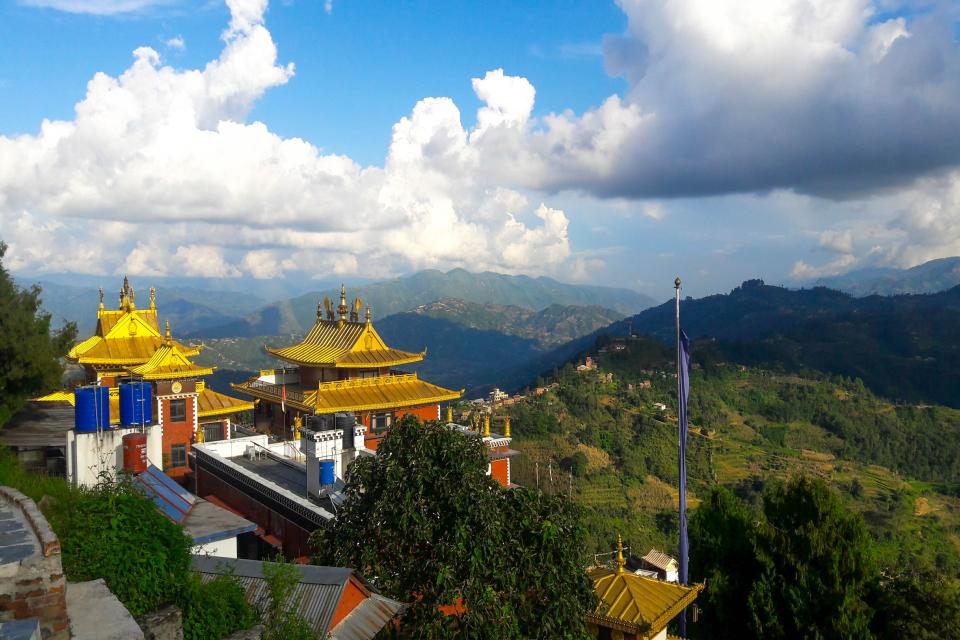Shivapuri & Nagi Gompa Hike - 1 Day
Insight on Shivapuri Nagi Gompa Hike
Embark on a scenic hike through Shivapuri National Park, beginning with a drive to Budhanilkantha Temple. Ascend to the serene Nagi Gompa Monastery, surrounded by stunning views of Kathmandu and the Langtang Himalayas. Continue through lush forests teeming with wildlife, including birds, monkeys, and leopards. Reach Baghdwar, the sacred source of the Bagmati River, before making a challenging climb to the summit at 2,563 meters. Enjoy panoramic views of snow-capped peaks like Ganesh Himal and Langtang Lirung. Engage with local yogis and sadhus, gaining spiritual insights during this unforgettable journey.
Trip at a Glance
Key Highlights
- Hike through Shivapuri National Park with beautiful landscapes, fresh streams, and diverse nature.
- Get a chance to spot exotic plants, 177 bird species, and wildlife like monkeys, leopards, and bears
- Visit the Nangi Gompa Monastery for meditation and spiritual experiences, with views of Kathmandu and Langtang Himalayas.
- See the source of the sacred Bagmati River and enjoy panoramic views from the summit (2,563 meters), including peaks like Ganesh Himal and Langtang Lirung.
- Meet local yogis, sadhus, and nuns at Nangi Gompa for spiritual insights.
Benefit of Shivapuri- Nagi Gompa Hike with BHT
- Experienced and professional tour guides enhance your understanding of each site.
- Travel in comfort with a private vehicle, ensuring a personalized experience.
- Tailored itineraries cater to your interests for a meaningful journey.
- Smooth and efficient transfers eliminate the stress of public transportation.
- Prioritized safety with reliable transportation and careful planning.
- Convenient booking and reservation process
- Multiple communication channels (Email, WhatsApp, Facebook, WeChat, Viber, Skype, Zoom)
- All logistical arrangements, including permits and transportation, are handled.
- 24/7 phone support at +977-9851149197/+9779810043046
Trip Overview
The journey starts with a calm 45-minute drive to Budhanilkantha Temple, set in the peaceful area of Shivapuri. This iconic Hindu site, also known as Narayanthan Temple, is home to a monumental statue of Vishnu lying peacefully on a pond. Just a short drive away from the temple, you’ll find the trailhead for an unforgettable hike through Shivapuri Nagarjun National Park.
The hike itself is quite accessible, beginning with a brief stone staircase that leads to Nagi Gompa, located in the northeast. The steady climb to Nagi Gompa takes roughly two- three hours. Perched on the slopes of Shivapuri Hill, Nagi Gumba is a serene Buddhist monastery home to the nuns, known as "anni." Both locals and visitors come to meditate in this peaceful setting, where the soft rustle of prayer flags in the breeze enhances the calm and reflective atmosphere. The monastery offers not only spiritual serenity but also remarkable views of Kathmandu Valley and the majestic Langtang Himalayas on clear days.
The path climbs upward from the monastery, meandering through dense oak woodlands and brilliant rhododendron groves. The air grows fresher and the scenery more vibrant as we climb. With its diverse flora and fauna, Shivapuri National Park is a hidden gem for nature lovers. You may catch sight of a variety of exotic birds, such as the colorful Himalayan griffon vulture or the elusive Himalayan monal, Nepal’s national bird. The park is also home to a wide array of rare orchids, and its lush forests provide refuge for animals like monkeys, leopards, and even bears. This area is one of the last remaining primary forests in the Kathmandu Valley, offering a glimpse into the rich biodiversity that still thrives here.
As we ascend, the trek rewards us with breathtaking vistas of the surrounding hills. After ascending nearly 700 meters above Nagi Gompa, we reach a significant landmark along the trail-Baghdwar. The name "Baghdwar" translates to "Tiger Gate" in Nepali, and it’s a place of great importance. The sacred Bagmati River, one of the holiest in the Kathmandu Valley, begins its journey here. The area is marked by a striking rock formation in the shape of a tiger, symbolizing the power and majesty of the region. This is also a spiritual hub, where you may encounter yogis and sadhus who have made this peaceful spot their home, offering you the chance to learn about their meditative practices and way of life.
As you progress higher, the rise to the Shivapuri summit lies ahead. At 2563 meters, this peak offers one of the most rewarding views in the valley. The final stretch to the summit, about 200 meters from Baghdwar, is challenging but highly worth the effort. From the top, you’ll be treated to panoramic views of the surrounding mountain ranges, including Ganesh Himal, Langtang Lirung, Langtang Ri, Ganjala Peak, Gaurishankar, and a number of other awe-inspiring peaks. The breathtaking vistas are complemented by the feeling of standing on top of the world, with nothing but fresh mountain air surrounding you.
The summit itself is a peaceful, flat area where you can take a break and enjoy a well-deserved picnic. As you sit and soak in the scenery, it’s easy to appreciate the beauty of the natural world that envelops you. Whether you’re sharing the moment with friends or simply reflecting on the journey, the tranquility and the sense of accomplishment at the summit are truly unparalleled.
This trek, with its perfect combination of natural beauty, spiritual significance, and challenging yet rewarding climbs, offers a glimpse into the diverse landscapes of Nepal, making it an ideal choice for both seasoned trekkers and beginners alike. Whether you’re looking for peace, excitement, or a stronger bond with the natural world, the trek through Shivapuri National Park offers an unforgettable experience that will resonate long after you've left the trail behind.
What to expect from this Trek?
1. Scenic Drive to Budhanilkantha Temple
The adventure begins with a peaceful 45-minute drive from Kathmandu to Budhanilkantha Temple. This picturesque journey takes you through the lush greenery and serene landscapes of the Shivapuri region, setting the tone for the rest of the trek. As you drive, you’ll notice the surrounding hills and the tranquil environment, which contrasts with the bustling city life of Kathmandu, giving you a sense of calm even before you start your hike.
2. Spiritual Encounter at Nagi Gompa
Once you reach Nagi Gompa, a Buddhist monastery, you'll step into a serene spiritual space. This peaceful location is home to nuns, known as "anni," who reside here and practice meditation. The atmosphere is quiet, with the gentle sound of prayer flags fluttering in the wind and the occasional chant reverberating through the air. The monastery provides a perfect opportunity to reflect and connect with the spiritual side of Nepal, offering stunning views of Kathmandu Valley and the Langtang Himalayas on clear days. It’s a place that invites both contemplation and awe.
3. Rich Biodiversity
As you continue your hike through Shivapuri National Park, the rich biodiversity of the area becomes evident. The park hosts a diverse range of plant and animal species, making it a haven for nature enthusiasts. You might catch a glimpse of some of the 177 species of birds that inhabit the park, including the vibrant Himalayan monal and the rare Himalayan griffon. The forest is also teeming with exotic orchids and diverse plant life. If you're lucky, you might spot wildlife such as monkeys, leopards, or even bears, adding an element of adventure to your journey. The diversity of life found here is one of the park's main attractions.
4. Baghdwar - Sacred Water Source
As you make your way to the top, you'll pass a prominent landmark called Baghdwar. Known as the "Tiger Gate," this sacred spot is where the holy Bagmati River begins its journey. The name "Baghdwar" comes from the tiger-shaped rock formation found in the area, symbolizing the power and spiritual significance of the place. Baghdwar is a spot of great importance for locals and visitors alike, offering the chance to learn about its cultural and spiritual significance. You might also encounter yogis and sadhus in the area, who live in solitude and practice meditation, providing an opportunity to engage with them and learn about their lifestyle.
5. Challenging Yet Rewarding Ascent
The final push to the summit of Shivapuri Hill is a steep but rewarding climb. At 2563 meters, the summit provides a panoramic view of the surrounding mountains. The 200-meter stretch from Baghdwar to the top might be physically demanding, but the sense of accomplishment when you reach the top is immense. The terrain can be challenging, but with determination, you’ll find the journey incredibly fulfilling. The views of the surrounding landscape make every step worthwhile, and the peace you find at the top is the perfect reward for your efforts.
6. Stunning Mountain Views
Upon reaching the summit of Shivapuri Hill, you'll be rewarded with some of the most stunning vistas in the Kathmandu Valley. On clear days, the summit offers a panoramic view of several towering peaks, including Ganesh Himal, Langtang Lirung, Langtang Ri, and Gaurishankar, among others. The sight of these majestic mountains stretching across the horizon, with their snow-capped peaks glistening in the sunlight, is nothing short of awe-inspiring. This incredible view is one of the highlights of the trek, making the challenging climb well worth it.
7. Sense of Accomplishment and Peace
The summit of Shivapuri Hill offers not only stunning views but also a profound sense of accomplishment. After the challenging climb, you’ll feel a deep satisfaction in reaching the top. It's a chance to pause and reflect on your journey, soak in the peace, and marvel at the surrounding natural beauty. The peaceful atmosphere, combined with the fresh mountain air and the panoramic vistas, creates the perfect setting for relaxation and a well-deserved break. This trek offers a brief but rewarding escape from the hustle and bustle of city life, providing a sense of peace and connection with nature that stays with you long after you return.
Itinerary
Early Morning: Departure from Kathmandu
- Pick-Up from Hotel
Start your day with a peaceful 45-minute drive from Kathmandu to Budhanilkantha Temple (also known as Narayanthan Temple). This iconic Hindu temple is home to a massive statue of Vishnu lying serenely on a pond, surrounded by lush greenery. This is the ideal starting point for your journey, providing a serene and uplifting environment that prepares you for the day ahead.
Morning: Hike to Nagi Gompa Monastery
- Reach Budhanilkantha Temple
Pause for a while to explore the temple and soak in the tranquil atmosphere. You can learn about the temple's significance, which has long been a revered site for locals and visitors alike. - Start the Hike to Nagi Gompa
After a quick visit to the temple, you'll hop in the vehicle for a short drive to the trailhead. From here, it’s time to lace up your boots and start your hike to Nagi Gompa, a Buddhist monastery located on the slopes of Shivapuri Hill. The trail begins with a stone staircase and gradually takes you into oak and rhododendron forests. The hike is scenic and peaceful; lasting about 2-3 hours, with the occasional view of the Kathmandu Valley unfolding below you as you climb. - Reach Nagi Gompa
Finally, you’ll arrive at Nagi Gompa, a tranquil monastery where nuns (known as "anni") practice meditation. Here, you can take a moment to breathe in the serenity and appreciate the stunning views of the Kathmandu Valley and the Langtang Himalayas (if the skies are clear). It’s a wonderful spot for reflection.
Midday: Exploration of Shivapuri National Park and Biodiversity
- Continue hiking to Baghdwar
After soaking in the peaceful vibes of Nagi Gompa, continue your hike deeper into Shivapuri National Park. This part of the park is a true nature lover’s paradise, with lush forests and a rich diversity of flora and fauna. Keep your eyes peeled for birds like the vibrant Himalayan monal or the majestic Himalayan griffon vulture. You may also spot monkeys, leopards, or even bears along the way!
- Reach Baghdwar (Tiger Gate)
Your next stop is Baghdwar, or the "Tiger Gate," where the sacred Bagmati River begins its journey. The area is named for a rock formation that resembles a tiger, adding to the spiritual aura of the place. Baghdwar is not just a natural site, but also a place of great spiritual importance. It’s a place where you may encounter yogis and sadhus, so take the chance to interact with them and learn about their meditation practices.
Afternoon: Summit of Shivapuri Hill
- Begin the Final Ascent to Shivapuri Hill Summit
From Baghdwar, it’s time for the final push to the top of Shivapuri Hill. This 200-meter climb is a bit challenging but worth every step. As you make your way up, the forest opens up, and the air becomes fresher. You’ll start to feel a sense of anticipation as the panoramic views begin to unfold. - Arrive at the Summit (2,563 meters)
After the climb, you’ll be rewarded with breathtaking views from the top. On clear days, the snow-capped peaks of Ganesh Himal, Langtang Lirung, Langtang Ri, and Gaurishankar stretch out before you. Spend some time soaking in the views and enjoying a well-deserved break. Whether you bring a light picnic or just enjoy the peaceful atmosphere, this is a moment to reflect on your journey.
Late Afternoon: Return to Kathmandu
- Begin the Descent
After savoring the views and your time at the summit, start your descent back toward Nagi Gompa. The downhill trek will be quicker, but take it easy and watch your step, as the trail can be slippery in some areas. - Arrive Back at Nagi Gompa
Once you reach the monastery, take a final moment to relax and enjoy the tranquility of the surroundings before heading back to Kathmandu. - Travel Back to Kathmandu
Hop in the vehicle for your drive back to Kathmandu. Enjoy the scenic journey as you reflect on your day and the beautiful nature you’ve experienced. You’ll arrive in the city in the evening which will generally take 30 minutes and 45 minutes if there is Traffic.
Evening: Arrival in Kathmandu
- Arrive at Your Hotel
You’ll be dropped off at your hotel in Kathmandu, bringing an end to your one-day trek through Shivapuri National Park. Relax and let the beauty of the day settle in as you enjoy a peaceful evening.
What is included?
- Private vehicle transport from the hotel to the starting point of the hike, and from the finish point back to the hotel.
- A highly experienced, knowledgeable, friendly, and English-speaking guide with government certification with their salary, food, accommodation, transport, and insurance.
- Entrance fees to Shivapuri National Park.
- Packed Lunch and Water Bottle
What is not included?
- Entrance fees to Shivapuri National Park.
- Visa fees for Nepal.
- International airfare to and from Kathmandu.
- Meals and accommodation in Kathmandu.
- Personal travel and health insurance
- Personal expenses.
- Tips for the trekking crew and driver.
- All government taxes 13%, SSF, and 10% service charges
Route Map
Equipment
Footwear:
- Hiking Shoes/Boots: Comfortable, sturdy shoes with good
- Socks: Moisture-wicking socks
Clothing:
- Lightweight, Breathable Clothes: Comfortable, moisture-wicking clothing
- Jacket/Outerwear: A lightweight, windproof, and waterproof jacket
- Hat and Sunglasses: hat or cap to protect from the sun, and sunglasses to shield your eyes from UV rays.
Essentials:
- Backpack: A small, comfortable daypack to carry your personal items.
- Water Bottle: Reusable water bottle to stay hydrated
- Snacks: nuts, granola bars, or dried fruit
- Sunscreen: SPF 30 or higher
- Insect Repellent: To keep mosquitoes and bugs at bay, especially in the forested areas.
Personal Items:
- Camera/Phone
- Cash: Carry few Nepali Rupees for any small purchases or donations.
- Identification: Carry a copy of your passport or identification
Trip Info
Best time for this Trek
Autumn (September to November) and spring (March to May) are the best times for the hike due to the optimal balance of weather and nature's rhythms.
In autumn, the monsoon season typically comes to a close, leaving the air crisp and the skies bright. This allows you to see the stunning vistas of the Kathmandu Valley and the snow-capped mountains in the distance. The trails are dry, so they’re easy to navigate, and the landscape is lush, with vibrant green hillsides that have been refreshed by the monsoon rains. The cooler temperatures prevent the air from being too humid, which makes the hike more pleasant.
Spring, in contrast, brings a vibrant energy to the surroundings. Temperatures are comfortably warm, which encourages plants to bloom-especially the beautiful rhododendrons, which cover the trails in shades of red, pink, and white. The forest is full of life, with birds chirping and flowers in bloom, making the hike both visually and emotionally uplifting. The clear skies also offer great views of the mountains, and the conditions are mild enough that you can enjoy the surroundings without being overwhelmed by heat or cold.
During monsoon (June to August), the landscape is affected by the heavy rains, which make the trails muddy and slippery, increasing the risk of accidents. The cloud cover also hides the views, and the rains can disrupt the natural serenity of the hike.
Winter, while still possible for hiking, brings colder temperatures and can even bring snow to higher elevations, making the trails more challenging and less accessible. However, it can also offer a serene beauty, with crisp air and clear skies, though the landscape can be stark, as fewer plants are in bloom and wildlife activity is quieter.
In essence, autumn and spring bring the best balance of natural beauty, comfortable conditions, and accessibility to the hike, allowing you to fully immerse in the vibrant environment of Shivapuri.
Things to consider for this Trek
1. Difficulty Level, Distance & Duration
The Budhanilkantha Nangi Gompa Shivapuri trek is considered a moderate hike, featuring some steep sections and a steady ascent, especially towards Shivapuri Peak. The hike usually lasts 6 to 7 hours, covering a distance of 15 to 20 km, depending on the selected path. It's important to be physically prepared for the uphill sections and the overall duration of the trek.
2. Altitude & Acclimatization
While Shivapuri Peak is at 2,732 meters, the hike is relatively short, and altitude sickness is unlikely. However, if you have any pre-existing health conditions, it's wise to consult with a doctor beforehand. Pay attention to your body, take regular breaks, and ensure you stay hydrated. If you feel any discomfort or dizziness, it's important to slow down and rest.
3. Clothing & Gear
Wear layered clothing since mountain weather can shift quickly. Opt for moisture-wicking fabrics and bring a light jacket or fleece for added warmth. Good hiking shoes are essential for navigating the rocky, uneven terrain and a rain jacket or poncho is recommended, especially during the monsoon. Don’t forget sun protection such as a hat, sunglasses, and sunscreen, as the higher altitudes can intensify UV exposure.
4. Wildlife & Nature
Shivapuri National Park is inhabited by a variety of wildlife, such as birds, monkeys, and deer. While trekking, take time to enjoy the natural beauty, but also respect the environment by carrying out any trash and minimizing your impact. Leave no trace of your presence.
5. Local Culture & Respect
Both Budhanilkantha and Nangi Gompa are sacred religious sites. Dress modestly, follow any guidelines, and be respectful of local customs and traditions when visiting these places. The locals are friendly and hospitable, so feel free to interact, but always be mindful of their cultural norms.
6. Permits
To enter Shivapuri National Park, you will need an entry permit, which can be acquired at the park's entrance, usually located at Nagarjun or Shivapuri. The fee is around NPR 100 for SAARC nationals and NPR 1,000 for non-SAARC tourists.
7. Environmental Responsibility
Practice leave no trace principles by taking care to pack out all trash, including food wrappers and plastic bottles. There are no trash bins on the trail, so be mindful of your environmental impact. Embrace sustainable hiking practices to help preserve the beauty of the area for future trekkers.
Review
Fantastic hike to shivapuri with amazing person
I must say this hike was possible one of the best hike I had gone in Kathmandu valley. Mr Bimal, what a fantastic person from best heritage tour. He managed each and everything and...
View DetailPeaceful environment of Nagi gompa
Talking to the monks in the Nagi gompa and knowing about the Buddhist religion from them was such an experience. Meditating for sometimes in the peaceful environment of Nagi gompa...
View Detailbeautiful views and great guide
Walking through the forest of shivapuri with our guide Raju while gaining knowledge about different types of plant and animals was such a new learning experience. I got to explore...
View DetailBest family friendly small hiking trail near Kathmandu
What a great family friendly small hiking trail near Kathmandu. A well- managed route and our family was very comfortable in the route.
View DetailFAQ's
While Nepali is the primary language, most staff members in lodges speak English, and some may even speak other languages. Communication should not be an issue for international tourists.
It’s advisable to be up-to-date on routine vaccinations, including hepatitis A and typhoid. Talk to your doctor about the vaccinations you need for Nepal.
The majority of international flights arrive at Tribhuvan International Airport, which is located in Kathmandu. From this location, travelers can connect to Lukla to commence their trekking journey.
You typically need a valid passport, a completed visa application form, and a passport-sized photo. Payment can be made in cash or via card at the airport.
Yes, tourist visas are eligible for extension at the Department of Immigration located in Kathmandu. Ensure you have a valid reason and required documents for the extension.
If you wish to extend your stay in Nepal beyond your visa’s initial duration, you can do so by applying at the Department of Immigration in Kathmandu. Extensions are available for a maximum of 30 days, and it’s recommended to apply before your current visa expires. Best Heritage Tour can help you with the extension process if required during your Australian Camp Trek.
The Shivapuri and Nagi Gompa Trek is a one-day adventure that takes you through the lush landscapes of Shivapuri National Park. You'll hike through forested paths, enjoy beautiful nature views, and visit Nagi Gompa, a peaceful Buddhist monastery. This trek offers an opportunity to experience both the natural beauty and cultural heritage of Nepal in one day, making it perfect for nature lovers and spiritual seekers alike.
The Shivapuri and Nagi Gompa Trek is designed as a one-day trip, typically lasting between 6 to 8 hours. It begins early in the morning and includes time for hiking through diverse terrains, reaching Nagi Gompa, and returning to Kathmandu in the afternoon. The duration may vary slightly depending on your pace and breaks, but it's generally manageable for most people with a basic fitness level.
The Shivapuri and Nagi Gompa Trek is rated as moderate in difficulty. While there are some uphill sections, it does not require advanced trekking skills. It’s suitable for people who are moderately fit and enjoy outdoor activities. If you're able to walk for several hours at a steady pace, you will find the trek enjoyable. Best Heritage Tour provides expert guidance to ensure a smooth and enjoyable experience.
During the Shivapuri and Nagi Gompa Trek, you will experience beautiful nature walks through dense forests, peaceful Buddhist culture at Nagi Gompa, and panoramic views of the Kathmandu Valley. The trek offers a combination of physical activity, serenity, and cultural immersion, with the chance to take in the scenic beauty of the surrounding mountains and valleys.
The trek starts in the outskirts of Kathmandu, where you'll be picked up from your hotel by Best Heritage Tour. You will then travel to the trailhead, begin your hike to Nagi Gompa, and return to the starting point after reaching the monastery. The round-trip journey ensures you have an enriching day surrounded by nature, with comfortable transport arrangements made by the tour operator.
Preparing for the Shivapuri and Nagi Gompa Trek involves being in moderate physical condition. It's helpful to do some light cardio activities like walking or hiking in the weeks leading up to the trek. Packing smart is also important-bring comfortable hiking boots, layered clothing, a hat, sunscreen, and enough water. Best Heritage Tour will provide specific guidance for your needs to ensure you are well-prepared.
Yes, the Shivapuri and Nagi Gompa Trek is family-friendly as it caters to moderate physical activity. The trek is a great way to introduce children or older family members to the beauty of Nepal’s natural landscapes and cultural heritage. However, younger children or individuals with limited mobility may find some parts of the trail challenging, so it's best to ensure everyone is physically capable.
No, prior trekking experience is not required for the Shivapuri and Nagi Gompa Trek. The trail is designed for people with a basic level of fitness, and no technical skills are needed. If you're accustomed to walking on uneven terrain and can handle a few hours of walking, you'll enjoy this trek. Best Heritage Tour’s experienced guides are there to assist you.
For the Shivapuri and Nagi Gompa Trek, bring essential items like sturdy hiking shoes, a rain jacket (depending on the season), a hat, sunglasses, sunscreen, and a water bottle. It’s also a good idea to bring snacks, a camera, and a small first-aid kit. Best Heritage Tour provides advice on what to pack based on the weather forecast and trek conditions.
The Shivapuri and Nagi Gompa Trek involves an elevation gain of approximately 1,000 meters, starting at around 1,500 meters and reaching around 2,500 meters at Nagi Gompa. The trek takes you uphill through the Shivapuri National Park, but the gradual ascent makes it manageable for most trekkers in good health. The altitude is not high enough to cause altitude sickness, but proper acclimatization and hydration are still important.
The best time to do the Shivapuri and Nagi Gompa Trek is during Nepal's spring (March to May) and autumn (September to November) seasons. These months offer mild temperatures, clear skies, and pleasant weather, making them ideal for outdoor activities. The winter months can be cold, while the summer brings the monsoon rains, which could affect visibility and trail conditions.
Yes, the Shivapuri and Nagi Gompa Trek is generally considered safe. The trails are well-maintained, and the trek does not involve high-altitude risks. However, it’s important to stay hydrated, wear proper footwear, and follow the guidance of your Best Heritage Tour guide. Safety measures and first-aid supplies are carried by your guide to handle any emergencies that may arise during the trek.
While it's possible to do the trek solo, it's recommended to join a guided group through Best Heritage Tour. The guides are familiar with the terrain, ensuring your safety, and provide insightful commentary on the culture and nature along the way. Solo trekking can be more challenging without proper knowledge of the trails and risks involved.
On the Shivapuri and Nagi Gompa Trek, you will encounter diverse landscapes, from lush forests and wildlife to serene Buddhist monasteries. This trek offers breathtaking panoramas of the Kathmandu Valley, the rolling hills that encircle it, and the majestic distant mountain ranges. You will also experience the tranquil atmosphere of Nagi Gompa, a sacred site for many local Buddhists.
Yes, during the Shivapuri and Nagi Gompa Trek, you'll have the opportunity to interact with local villagers and monks around Nagi Gompa. These encounters offer valuable insights into the rural lifestyle and Buddhist culture of the region. Best Heritage Tour ensures that these interactions are respectful and enriching for both trekkers and locals.
Nestled within the serene surroundings of Shivapuri National Park, Nagi Gompa is a tranquil Buddhist monastery renowned for its spiritual ambiance and picturesque setting. The monastery is a spiritual retreat for monks and visitors, offering a serene environment for meditation and reflection. It is a key stop on the Shivapuri and Nagi Gompa Trek, where trekkers can learn about Buddhist practices and enjoy a calm atmosphere surrounded by nature.
Yes, the Shivapuri National Park, through which you’ll trek, is home to various species of wildlife, including birds, deer, and monkeys. While sightings are not guaranteed, the park’s rich biodiversity makes it an exciting place to observe nature. Best Heritage Tour ensures that you are guided through areas where wildlife is more likely to be seen.
Yes, the trek has significant cultural and spiritual importance, particularly the visit to Nagi Gompa, which is an active Buddhist monastery. Many locals and monks come to this monastery for meditation and prayer. Visitors often find this part of the trek to be both calming and inspiring, providing a deeper connection to the spiritual heritage of Nepal.
Absolutely! After completing the Shivapuri and Nagi Gompa Trek, many trekkers choose to explore more of Kathmandu or visit other nearby destinations. Best Heritage Tour can help arrange additional tours or transportation to ensure you can make the most of your time in Nepal.
Booking the Shivapuri and Nagi Gompa Trek through Best Heritage Tour is simple. You can contact them via their website, phone, or email to secure your spot. The team will provide all the details about the trek, including the itinerary, packing list, and payment options.
The Shivapuri and Nagi Gompa Trek typically experiences pleasant and moderate weather conditions. Expect cool temperatures in the morning and evening, with warm temperatures during midday, especially in spring and autumn. It can get chilly in the early hours, so layering your clothing is essential. It’s a good idea to check the weather forecast closer to your trekking dates to get the most accurate and up-to-date information.
The most favorable time to embark on the Shivapuri and Nagi Gompa Trek is during spring (March to May) and autumn (September to November). These periods provide pleasant weather, clear skies, and excellent visibility, creating perfect conditions for hiking and sightseeing. In contrast, winter can be chilly, particularly in the mornings and evenings, while the summer months often experience monsoon rains that may lead to slippery trails and reduced visibility.
The temperatures experienced during the trek can vary significantly based on the time of year you choose to travel. During the day, temperatures typically range between 10°C to 20°C. At higher altitudes, like around Nagi Gompa, it can get cooler, especially in the mornings and evenings. Ensure you pack warm layers, particularly during the colder months of the year.
Weather can impact visibility and trail conditions. During the monsoon season, the trail may become slippery, and rains can obscure views of the Kathmandu Valley. Winter can bring cold temperatures, especially at higher elevations. However, Best Heritage Tour provides up-to-date weather information and adjusts the itinerary if necessary to ensure safety.
While it’s possible to trek in Shivapuri during the monsoon (June to August), it’s not ideal. The trail can be slippery, and there is a higher chance of rain, which could affect visibility. It’s recommended to trek in the drier months of spring and autumn for a more comfortable and safe experience. Best Heritage Tour can guide you on the best timing for your trek.
Layering is key when trekking to Shivapuri and Nagi Gompa. For cooler mornings and evenings, wear warm clothing, such as a jacket or fleece, and for warmer afternoons, opt for light, breathable fabrics. Ensure your footwear is sturdy and suitable for hiking on uneven terrain. Best Heritage Tour can provide a detailed packing list based on the weather forecast.
Rainfall is more likely during the monsoon season (June to August). However, during the spring and autumn months, rainfall is minimal, and you are likely to experience clear skies and moderate temperatures, making it an ideal time for the trek.
If weather conditions deteriorate during the trek, Best Heritage Tour’s experienced guides will assess the situation and make decisions to ensure your safety. They will provide alternative routes or return if conditions are unsafe. Trekking with a guided tour ensures proper safety protocols are in place.
To participate in the Shivapuri and Nagi Gompa Trek, you need a valid tourist visa for Nepal. Visas can be obtained upon arrival at Tribhuvan International Airport or through Nepalese embassies abroad. A 15-day, 30-day, or 90-day visa is available for most travelers. Best Heritage Tour can assist with any necessary paperwork or guide you through the visa application process if needed.
The trek starts outside of Kathmandu. Best Heritage Tour arranges transport for all participants from your hotel in Kathmandu to the starting point of the trek. The drive takes about 45 minutes to an hour, depending on traffic conditions, and ensures a smooth transition from the city to the natural environment where your trek will begin.
Yes, transportation is included in the Shivapuri and Nagi Gompa Trek package. Best Heritage Tour provides comfortable transportation from your accommodation in Kathmandu to the trailhead and back after the trek. This arrangement eliminates the hassle of navigating public transport and ensures you can focus entirely on enjoying the trek itself.
The easiest way to reach Nepal for the trek is by flying into Tribhuvan International Airport in Kathmandu. Major airlines operate flights to Nepal from around the world. Best Heritage Tour can assist in arranging airport transfers, making it convenient to start your trek as soon as you arrive.
Typically, you don’t need to show your visa at the start of the Shivapuri and Nagi Gompa Trek itself. However, it’s important to ensure that your visa is valid while in Nepal, especially when entering the country. If you're unsure about your visa requirements, Best Heritage Tour can offer assistance and provide the latest information.
For the trek, you will need a valid passport with a Nepal tourist visa. Additionally, it’s a good idea to carry photocopies of your passport and visa in case of loss. Best Heritage Tour will help you with any additional documentation required for the trek, ensuring you have everything necessary for a smooth experience.
Yes, you can join the Shivapuri and Nagi Gompa Trek immediately upon arrival in Nepal, provided you have your visa and necessary documents. Best Heritage Tour can accommodate last-minute bookings, but it’s recommended to book in advance to secure your spot and allow enough time for travel arrangements.
The cost of the Shivapuri and Nagi Gompa Trek varies based on the package you choose. The tour price typically includes transportation, guide services, permits, and lunch during the trek. Best Heritage Tour will provide an accurate breakdown of the cost based on the number of participants and any additional services you may require.
The price of the trek includes transportation to and from the trek, a professional guide, park entrance fees, and lunch during the trek. It also covers any necessary permits and services provided by Best Heritage Tour to ensure you have a comfortable and enjoyable experience. However, it’s important to note that accommodation, personal expenses, and tips are not included.
Apart from the package cost, there may be additional costs such as personal snacks, extra meals, tips for guides and porters, and any optional activities. While the trek covers most major expenses, it’s a good idea to budget for small extras, including souvenirs or additional beverages during the trek.
Best Heritage Tour accepts various payment methods, including bank transfers, credit cards, and payments via online platforms like PayPal. You can discuss the available options with the tour operator, who will guide you through the booking and payment process. Make sure to confirm the payment method that works best for you prior to booking.
Yes, a deposit is usually required to secure your booking for the Shivapuri and Nagi Gompa Trek. The deposit amount is typically a percentage of the total cost of the trek and ensures your reservation is confirmed. The remaining balance is due before or upon arrival for the trek. Best Heritage Tour will provide specific details when you make your booking.
Refund policies vary depending on the time of cancellation. Best Heritage Tour offers a flexible cancellation policy, but you may be subject to cancellation fees depending on how far in advance you cancel. For a full refund or more details, you should check the specific terms and conditions provided during booking.
Tips for your guide and driver are not included in the price of the trek and are entirely at your discretion. However, tips are greatly appreciated for the services provided. Best Heritage Tour can give you general recommendations on how much to tip, depending on the level of service you experience during your trek.
Yes, you can pay in Nepali rupees for the Shivapuri and Nagi Gompa Trek, either directly or through local payment platforms. Best Heritage Tour accepts payments in both US dollars and Nepali rupees, depending on your preference and current exchange rates. Be sure to discuss the payment options at the time of booking.
While there is no strict age limit for the Shivapuri and Nagi Gompa Trek, it is generally suitable for participants between the ages of 10 and 65. The trek is moderate in difficulty, and individuals who are physically active and in good health should be able to handle it comfortably. Best Heritage Tour will assess each participant’s fitness level to ensure the trek is appropriate for them.
A moderate level of physical fitness is recommended for the Shivapuri and Nagi Gompa Trek. The trek involves hiking for several hours, with some uphill sections, so it’s important to be in reasonably good condition. If you're active and can handle a few hours of walking on uneven terrain, you should be able to enjoy the trek. Best Heritage Tour provides additional tips for preparing physically.
Elderly people in good health and with regular physical activity can join the Shivapuri and Nagi Gompa Trek. However, it’s important to ensure that the trek is suitable for their fitness level. Best Heritage Tour suggests consulting with the tour operator before booking to discuss any concerns about the difficulty or suitability of the trek.
Children, especially those aged 10 and above, can join the Shivapuri and Nagi Gompa Trek, provided they are in good health and enjoy physical activity. The trek’s moderate difficulty level makes it suitable for children who are accustomed to walking or hiking. Best Heritage Tour recommends checking with them regarding the child’s fitness and preparedness for the hike.
No special training is required for the Shivapuri and Nagi Gompa Trek, but it’s helpful to be physically active beforehand. Regular walking or light hiking will prepare you for the trek. Training helps with stamina and endurance, making the hike more enjoyable. Best Heritage Tour can offer advice on preparation for those concerned about their fitness.
If you have heart problems, severe respiratory conditions, or any medical issues that limit your ability to walk or hike, it’s advisable to consult a doctor before attempting the Shivapuri and Nagi Gompa Trek. Best Heritage Tour encourages all participants to check their health condition to ensure the trek is suitable for them.
The Shivapuri and Nagi Gompa Trek involves walking on uneven, hilly terrain and is not ideal for people with limited mobility. Best Heritage Tour can assist with alternative accessible tours around Kathmandu for those with mobility challenges, ensuring a fulfilling experience without physical strain.
No, there are no gender-specific requirements for the Shivapuri and Nagi Gompa Trek. The trek is open to people of all genders. Best Heritage Tour aims to create an inclusive environment for all participants, ensuring everyone has an enjoyable and safe experience.
The accommodation during the Shivapuri and Nagi Gompa Trek is typically in simple, clean guesthouses or lodges that offer a cozy and comfortable environment. Best Heritage Tour ensures that the lodging is safe and comfortable, suitable for trekkers of all levels.
Yes, meals are included in the Shivapuri and Nagi Gompa Trek package. During the trek, you will enjoy traditional Nepali meals like dal bhat, as well as international options such as pasta, soups, and sandwiches. Best Heritage Tour provides lunch on the trek day, ensuring you have nutritious and energizing meals to keep you fueled for the hike.
Yes, special dietary requests such as vegetarian, vegan, or gluten-free meals can be accommodated on the Shivapuri and Nagi Gompa Trek. When booking your trek with Best Heritage Tour, be sure to inform them of any dietary preferences or restrictions, and the team will make arrangements with the accommodations to meet your needs.
The meals provided during the Shivapuri and Nagi Gompa Trek typically include Nepali staples like dal bhat (lentil soup with rice), chapati, and vegetables, as well as lighter options like sandwiches and pasta. Best Heritage Tour ensures that meals are wholesome, nutritious, and suitable for providing energy throughout the day.
Bottled water is not always included in the trek package, so it’s important to carry your own water bottle. You can refill your water at various points along the trek, where purified water is available for purchase. Best Heritage Tour recommends bringing a refillable water bottle to minimize plastic waste and stay hydrated.
No, you do not need to bring your own food on the Shivapuri and Nagi Gompa Trek. The tour package includes meals provided at guesthouses along the route. However, if you have specific snacks or energy bars that you prefer, it is advisable to bring them along to supplement the meals during the trek.
The Shivapuri and Nagi Gompa Trek is designed for those looking for a moderate experience, so accommodations are typically simple and rustic. While luxury accommodations are not available on this trek, Best Heritage Tour ensures that the lodges and guesthouses provide clean and comfortable facilities for trekkers.
Best Heritage Tour takes food hygiene seriously and works only with lodges and guesthouses that maintain a high standard of cleanliness. The meals prepared along the trek are freshly cooked, using clean utensils and locally sourced ingredients. It’s always recommended to drink boiled or purified water to ensure safety during your trek.
Essential items for the Shivapuri and Nagi Gompa Trek include comfortable hiking shoes, a waterproof jacket, warm layers, sunscreen, a hat, and a water bottle. It’s also important to bring toiletries, a first aid kit, and a camera. Best Heritage Tour will provide a detailed packing list to ensure you’re well-prepared for the trek.
Yes, you will need a daypack to carry your essentials during the Shivapuri and Nagi Gompa Trek. This should include items like water, snacks, a camera, sunscreen, and your personal belongings. Best Heritage Tour recommends keeping your pack light to ensure comfort during the hike.
Trekking poles are not mandatory for the Shivapuri and Nagi Gompa Trek, but they can provide extra stability and reduce strain on your knees, especially during downhill sections. Best Heritage Tour can recommend renting or purchasing trekking poles if you feel you need extra support during the trek.
No, a sleeping bag is not required for the Shivapuri and Nagi Gompa Trek, as the guesthouses typically provide bedding. However, if you prefer extra warmth or comfort, you may bring a lightweight sleeping bag. Best Heritage Tour can provide advice on what is most suitable for the trek conditions.
Yes, bringing a camera is highly recommended for the Shivapuri and Nagi Gompa Trek. The trek offers stunning views of the surrounding nature, including lush forests and the serene Nagi Gompa monastery. Be sure to pack extra memory cards or batteries to capture the memorable moments of your adventure.
Yes, it’s possible to rent trekking equipment in Kathmandu for the Shivapuri and Nagi Gompa Trek. You can find rental shops offering items such as trekking poles, sleeping bags, and jackets. Best Heritage Tour can recommend trusted rental providers and assist you in acquiring any necessary gear before your trek.
While Best Heritage Tour provides a basic first aid kit for the group, it’s always a good idea to carry your own personal first aid kit. This should include items like plasters, pain relievers, blister pads, and any personal medications. This ensures you are prepared for any minor issues during the trek.
The weather can get chilly, especially in the early mornings and evenings, so packing warm layers is essential. A good fleece jacket, insulated gloves, a warm hat, and a down jacket are recommended for colder conditions. Best Heritage Tour advises you to dress in layers to ensure you can adjust according to changing temperatures.
The Shivapuri and Nagi Gompa Trek requires a moderate level of fitness. While it is not overly strenuous, it involves walking for several hours on uneven terrain, with some uphill sections. Regular walking, light hiking, or other cardiovascular activities can prepare you. Best Heritage Tour recommends participants be physically active and comfortable with walking for extended periods.
The trek features some moderate physical challenges, including uphill ascents and descending on uneven trails. While the trek is not extremely difficult, having a good level of physical fitness will ensure that you are comfortable throughout. Best Heritage Tour suggests preparing for a mix of terrain to enjoy the trek fully.
Before embarking on the Shivapuri and Nagi Gompa Trek, ensure you are in good health. Best Heritage Tour advises you to visit a doctor to check for any conditions that may interfere with your trek, such as heart issues or respiratory problems. It’s also important to be up-to-date on any vaccinations recommended for travel in Nepal.
The Shivapuri and Nagi Gompa Trek is generally safe, with minimal health risks. However, participants should be mindful of their hydration and rest when needed. It’s important to be aware of any pre-existing health conditions. Best Heritage Tour provides safety information to ensure all trekkers have a smooth and healthy experience.
Travel insurance is not mandatory, but it is highly recommended for the Shivapuri and Nagi Gompa Trek. Travel insurance provides coverage for unexpected events such as medical emergencies, trip cancellations, or lost baggage. Best Heritage Tour encourages trekkers to purchase insurance that includes coverage for trekking in Nepal and medical evacuation if necessary.
Best Heritage Tour prioritizes safety during the Shivapuri and Nagi Gompa Trek by providing experienced guides who are trained in first aid. The group is equipped with necessary communication tools for emergencies, and the trek follows safe, well-established routes. Participants will also receive pre-trek safety briefings.
Altitude sickness is unlikely on the Shivapuri and Nagi Gompa Trek due to the lower elevation. However, if you feel unwell, it’s important to rest, stay hydrated, and avoid overexerting yourself. Best Heritage Tour takes all precautions to ensure a comfortable trekking experience, including offering advice on staying safe during the trek.
If you feel ill during the trek, it’s important to inform your guide immediately. Best Heritage Tour provides experienced guides who can assess your condition and take appropriate action. They will ensure you are comfortable and can rest or be transported back to a safe location if necessary.
While medical facilities are limited along the Shivapuri and Nagi Gompa Trek, your guide will be equipped with a basic first aid kit to handle minor injuries or illnesses. For more serious conditions, the nearest medical facility is in Kathmandu, and Best Heritage Tour is prepared to help with emergency evacuation if needed.
There are no mandatory vaccinations for the Shivapuri and Nagi Gompa Trek, but it is advisable to be up-to-date on routine vaccinations such as tetanus, typhoid, and hepatitis. Best Heritage Tour recommends consulting with a healthcare provider before traveling to Nepal for any specific vaccination advice.
It is best to choose a comprehensive travel insurance policy that covers medical emergencies, trip cancellations, and emergency evacuation. Ensure the policy covers high-altitude trekking activities like the Shivapuri and Nagi Gompa Trek. Best Heritage Tour can provide more information on recommended insurance providers.
Best Heritage Tour does not provide travel insurance directly but can recommend trusted insurance companies with coverage suitable for trekking in Nepal. It’s important to arrange travel insurance well before your trip to ensure coverage from the start of your journey.
Most comprehensive travel insurance policies that Best Heritage Tour recommends do cover emergency evacuation if required. This ensures that trekkers are transported safely to the nearest medical facility if needed. It is vital to confirm the details of the coverage with your insurance provider before purchasing.
Travel insurance typically covers medical emergencies, accidental injuries, trip cancellations, lost luggage, and emergency evacuation. Best Heritage Tour suggests purchasing a policy that specifically includes coverage for trekking in Nepal to ensure full protection during your adventure.
If you need to make a claim, contact your insurance provider directly. You will need to provide details of the incident, such as medical reports or receipts, and any other required documentation. Best Heritage Tour can assist you with guidance on how to proceed in case of an emergency.
Yes, you can arrange travel insurance even after booking the Shivapuri and Nagi Gompa Trek. It is advisable to purchase insurance as soon as possible to ensure coverage for the entire duration of your journey, including the trek itself. Best Heritage Tour can provide advice on suitable insurance providers.
While personal health insurance may cover some medical costs, it is unlikely to include coverage for activities such as trekking or emergency evacuation in Nepal. Best Heritage Tour strongly recommends purchasing specific travel insurance that includes high-altitude trekking and other activities relevant to the Shivapuri and Nagi Gompa Trek.
Yes, you will need to book flights to Kathmandu to begin your Shivapuri and Nagi Gompa Trek. Best Heritage Tour can provide advice on the best flight routes and times, as well as help you coordinate your arrival in Nepal to align with the trek schedule.
Generally, airport pick-up is not included in the Shivapuri and Nagi Gompa Trek package. But Best Heritage Tour will arrange to pick you up from Tribhuvan International Airport in Kathmandu and transfer you to your accommodation. The team will also ensure a smooth transfer to the trek’s starting point.
No, local transportation is typically handled by Best Heritage Tour. They provide the necessary transport to and from the trek, ensuring you are taken to the starting point and returned to Kathmandu comfortably. No additional local transportation arrangements are required.
Yes, private transportation options are available during the Shivapuri and Nagi Gompa Trek. If you prefer a more personalized experience, Best Heritage Tour can arrange for private vehicles for transport to the trek starting point or any additional trips within Kathmandu.
While Best Heritage Tour does not directly book flights, they can assist you in finding the best flight options and offer guidance on flight schedules and connections. Their team will help you coordinate your flight arrival in Kathmandu for a seamless trekking experience.
Yes, transportation back to Kathmandu is included after completing the Shivapuri and Nagi Gompa Trek. Best Heritage Tour will arrange a private vehicle to return you to your hotel or directly to the airport, depending on your travel plans.
Yes, solo travelers are welcome to join the Shivapuri and Nagi Gompa Trek. Best Heritage Tour ensures that all solo trekkers have a supportive and guided experience with a professional guide and group if necessary. It's a great opportunity to meet new people while enjoying the trek.
The Shivapuri and Nagi Gompa Trek is perfect for group travel. Whether with friends, family, or fellow adventurers, Best Heritage Tour provides a group-friendly environment, making the trek a memorable shared experience. Groups can benefit from added camaraderie and team support during the trek.
Yes, you will be assigned to a group for the Shivapuri and Nagi Gompa Trek unless you prefer a private experience. Best Heritage Tour ensures that groups are manageable, and you’ll be able to trek with others who have similar fitness levels and interests, making it enjoyable and safe.
Yes, Best Heritage Tour offers the option to request a private group for the Shivapuri and Nagi Gompa Trek. Whether you are traveling with family, friends, or colleagues, you can arrange a personalized experience with tailored itineraries and accommodations.
Best Heritage Tour keeps group sizes manageable for the Shivapuri and Nagi Gompa Trek. The maximum group size typically ranges between 10 to 12 people, ensuring that everyone receives adequate attention and support from the guide. Smaller groups enhance the overall experience, providing a more personalized journey.
Yes, it is safe to travel solo on the Shivapuri and Nagi Gompa Trek, as long as you take basic precautions. Best Heritage Tour provides a knowledgeable guide to ensure your safety and well-being throughout the trek. Solo trekkers also join group trekking experiences for added support.
Yes, if you are traveling solo, you can request a customized itinerary for the Shivapuri and Nagi Gompa Trek. Best Heritage Tour offers flexibility to adjust the pace, accommodations, and route to suit your personal preferences, allowing for a tailored trekking experience.
If you don’t have a travel companion, you can join the Shivapuri and Nagi Gompa Trek as an individual. Best Heritage Tour groups solo travelers with others, making it a social experience. It’s an excellent opportunity to meet fellow trekkers while enjoying the scenic beauty of Nepal.
The Shivapuri and Nagi Gompa Trek is not fully accessible for people with severe mobility disabilities due to its uneven and sometimes steep terrain. However, Best Heritage Tour can help arrange alternative experiences or modifications based on individual accessibility needs to ensure an enjoyable visit to the region.
Certain areas of the Shivapuri and Nagi Gompa Trek involve steep ascents and uneven paths, which can be challenging for those with limited mobility. Best Heritage Tour can provide recommendations for adjustments or alternative routes if you require easier accessibility.
Trekkers with special accessibility needs should contact Best Heritage Tour before booking the Shivapuri and Nagi Gompa Trek to discuss their requirements. The tour operator can suggest possible adjustments and provide advice on suitable routes and accommodations based on individual accessibility needs.

